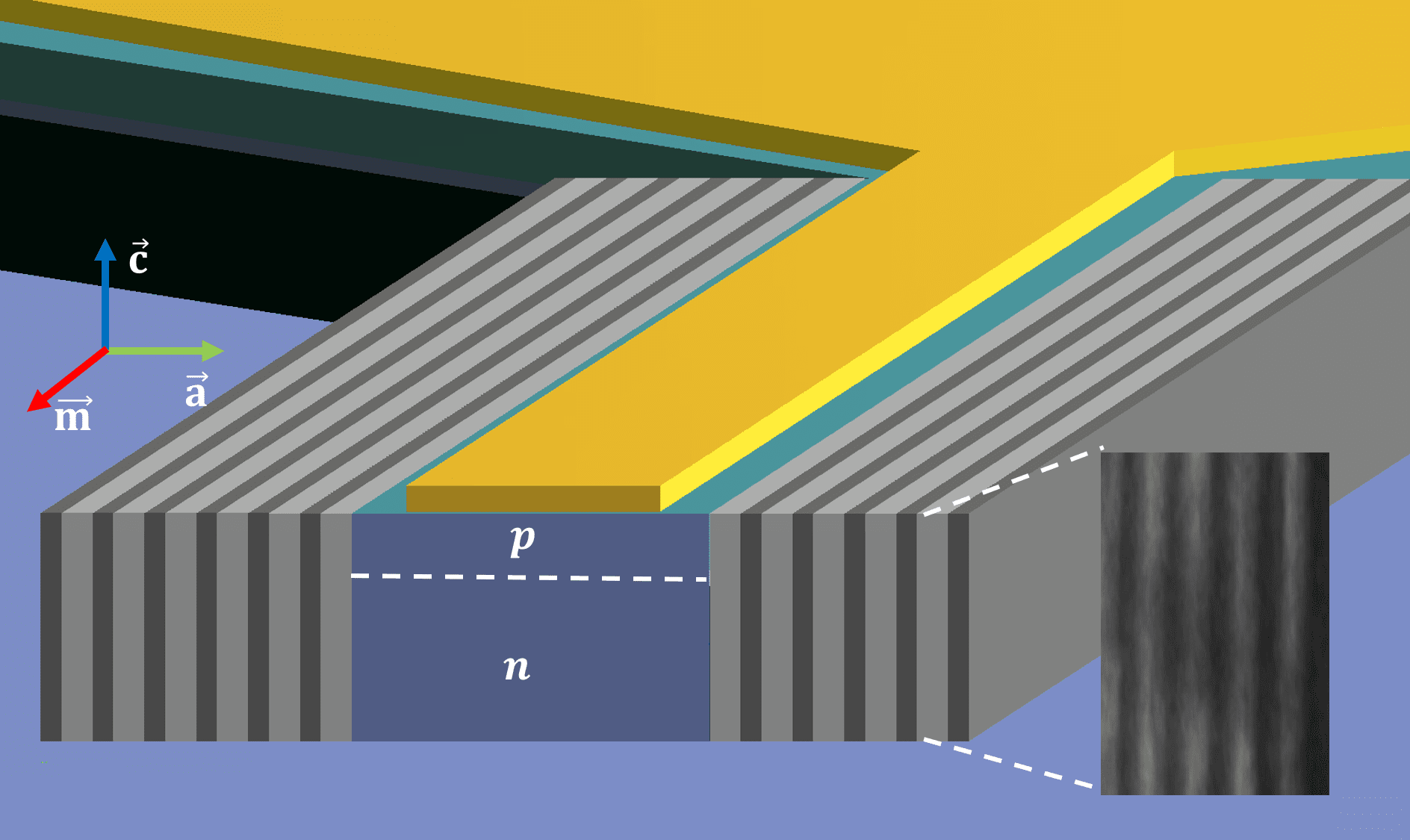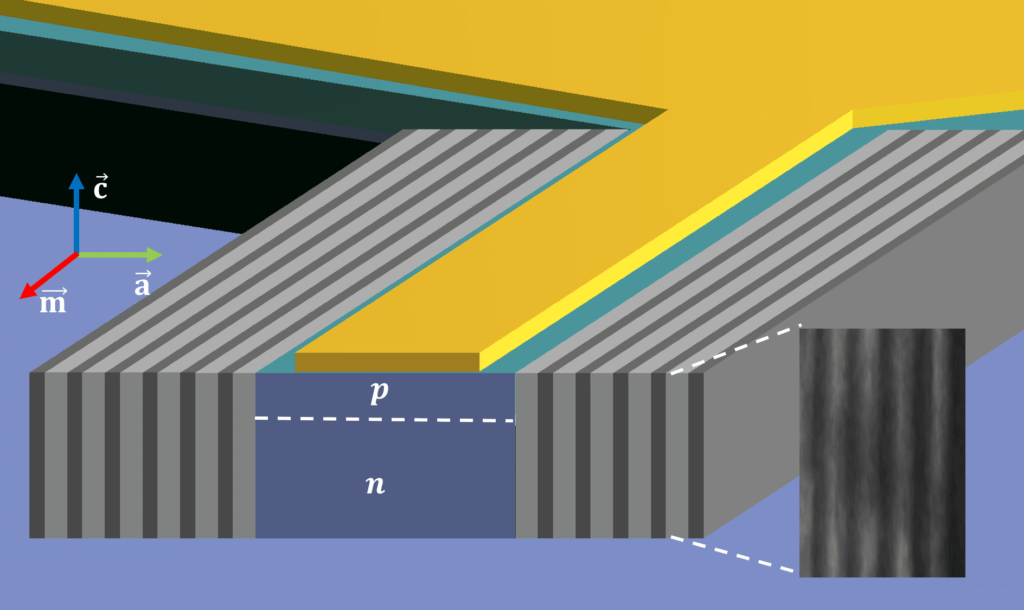University of Michigan researchers have demonstrated what’s believed to be the first practical polariton laser, which makes light beams in a more efficient way than conventional lasers. To accomplish this, they devised an innovative design that involved moving the required mirrors from the top and bottom of the device to the sides. The mirrors are represented by the gray bars. The yellow is the electrode through which the researchers stimulate the laser. The purple is the gallium nitride semiconductor that is able to maintain ideal conditions for polaritons to form and release light. Image credit: Thomas Frost
The beam they demonstrated was ultraviolet and very low power — less than a millionth of a watt. For context, the laser in a CD player is about one-thousandth of a watt.
With precarious particles called polaritons that straddle the worlds of light and matter, University of Michigan researchers have demonstrated a new, practical and potentially more efficient way to make a coherent laser-like beam.
They have made what’s believed to be the first polariton laser that is fueled by electrical current as opposed to light, and also works at room temperature, rather than way below zero.
Those attributes make the device the most real-world ready of the handful of polariton lasers ever developed. It represents a milestone like none the field has seen since the invention of the most common type of laser – the semiconductor diode – in the early 1960s, the researchers say. While the first lasers were made in the 1950s, it wasn’t until the semiconductor version, fueled by electricity rather than light, that the technology took off.
This work could advance efforts to put lasers on computer circuits to replace wire connections, leading to smaller and more powerful electronics. It may also have applications in medical devices and treatments and more.
Read more . . .
The Latest on: Polariton laser
[google_news title=”” keyword=”Polariton laser” num_posts=”10″ blurb_length=”0″ show_thumb=”left”]
via Google News
The Latest on: Polariton laser
- Best laser engravers of 2024on May 15, 2024 at 5:03 am
We compared the best laser engravers to find out which ones are a cut above the rest. As home-crafts grow in popularity, laser engraving machines have become more accessible than ever before.
- The Best Rotary Laser Levels of 2024, Tested and Reviewedon May 14, 2024 at 4:16 am
Rotary laser levels are invaluable tools on jobsites where maintaining accuracy over a wide area or a long distance is crucial. They determine slopes and grades as well as horizontal and vertical ...
- Laser Clinics was a global success story, but like so many before, a franchising scandal could bring it undoneon May 12, 2024 at 5:01 am
Laser Clinics, which offers laser hair removal, injectables and other non-surgical cosmetic treatments, first opened in Australia in 2008 and now has more than 200 clinics globally. It's battling ...
- Chinese scientists want to use lasers to power ultrafast, stealthy submarines. A laser expert says there's a major flaw in their plan.on April 28, 2024 at 3:28 am
Chinese researchers say they have made a breakthrough in laser propulsion technology that could one day be used on submarines and missiles. A laser propulsion expert at McGill University told ...
- At-Home Laser Hair Removal Gets You Silky-Smooth Skin for Hundreds Less Than In-Salon Treatmentson April 22, 2024 at 4:59 pm
But it always takes so much time, and the hair grows back so fast. Enter: laser hair removal, and specifically at-home laser hair removal. At-home laser hair removal devices are taking the beauty ...
- Does at-home laser hair removal work? Yes, but not as well as you might think.on April 21, 2024 at 5:01 am
Oh, I love those sunglasses. Maybe Baxter needs a doggie slip-and-slide. Hmmm – that at-home laser hair removal device looks pretty nifty. What if I never needed to shave again? I could save so ...
- 4 of the Best Home Laser Hair Removal Devices by Hair Color, Coarseness, and Moreon April 17, 2024 at 5:00 pm
Here’s our process. You used to have to visit a dermatologist for laser hair removal, and this is still the most effective route, but you can consider home laser hair removal devices instead.
- The Best At-Home Laser Hair Removal Device for Professional Looking Resultson April 7, 2024 at 1:57 pm
This content is created independently from TIME’s editorial staff. Learn more about it. At-home laser hair removal devices are suitable alternatives to in-office treatments for people looking ...
- 6 Best Cold Laser Therapy Devices to Use at Homeon December 6, 2023 at 5:51 pm
While there are plenty of ways to combat aches and pains, the rise of cold laser therapy devices offer a unique opportunity to cater your inner and outer wellness in equal measure. Despite what ...
- Polariton diode microcavitieson June 30, 2023 at 2:40 pm
Now, if the external pumping is provided by a laser operating at a frequency resonant with one of the exciton–polariton modes, the absorption of light is much more efficient in the strong ...
via Bing News













